Retrocalcaneal Bursitis
Updated:
What is retrocalcaneal bursitis?
Retrocalcaneal bursitis is a condition characterized by tissue damage and inflammation of the retrocalcaneal bursa (a small fluid filled sac located at the back of the heel) causing pain in the heel region.
A bursa is a thin fluid filled sac found in various places throughout the body. Bursae are designed to reduce friction between adjacent layers of tissue and are filled with lubricating fluid. They are typically located in regions of the body where tissue layers may rub against each other or against bony prominences (figure 1).
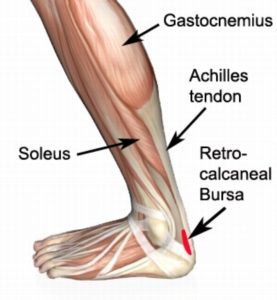
The muscle group at the back of the lower leg is commonly called the calf. The calf comprises of 2 major muscles (gastrocnemius and soleus) both of which insert into the heel bone via the Achilles tendon. Between the Achilles tendon and the heel bone lies a bursa known as the retrocalcaneal bursa (figure 1).
During contraction of the calf muscle, tension is placed through the Achilles tendon and this rubs against the retrocalcaneal bursa. Compressive forces and friction may also be placed on the retrocalcaneal bursa during certain ankle movements or by wearing excessively tight shoes. When these forces are excessive due to too much repetition or high force, irritation and inflammation of the bursa may occur. This condition is known as retrocalcaneal bursitis.
Signs and symptoms of retrocalcaneal bursitis
Patients with this condition typically experience pain at the back of the ankle and heel where the Achilles tendon attaches into the heel bone. Pain is typically experienced during activities requiring strong or repetitive calf contractions (often involving end of range ankle movements) such as walking (especially uphill), going up and down stairs, running, jumping or hopping (especially whilst wearing excessively tight shoes). Often pain may be worse with rest after these activities (especially that night or the following morning). The pain associated with this condition may ‘warm up’ with activity in the initial stages of injury. As the condition progresses, patients may experience symptoms that increase during sport or activity, affecting performance. In severe cases, patients may walk with a limp or be unable to weight bear on the affected leg. Other symptoms may include tenderness on firmly touching the affected bursa and swelling around the Achilles region.
Diagnosis of retrocalcaneal bursitis
A thorough subjective and objective examination from a physiotherapist may be all that is necessary to diagnose a retrocalcaneal bursitis. Diagnosis may be confirmed with an ultrasound investigation, MRI or CT scan.
Treatment for retrocalcaneal bursitis

Members Only ContentBecome a PhysioAdvisor Member to gain full access to this exclusive content. For more details see Become a Member. Already a member? Login Now
Prognosis of retrocalcaneal bursitis
Most patients with retrocalcaneal bursitis heal well with appropriate physiotherapy. Minor cases that have not been present for long can usually recover within a few weeks. In patients with severe symptoms or those who have had their condition for a long period of time, recovery can be a lengthy process and may take a number of months if not managed appropriately. Early treatment is therefore vital to hasten recovery and improve the outcome.
Contributing factors to the development of retrocalcaneal bursitis
There are several factors which can predispose patients to developing this condition. These need to be assessed and corrected with direction from a physiotherapist and may include:
- poor foot biomechanics (particularly flat feet)
- inappropriate footwear (e.g. excessively tight fitting shoes)
- muscle weakness (particularly the calf, quadriceps and gluteals)
- muscle tightness (particularly the calf)
- joint stiffness (particularly the ankle, subtalar joint or foot)
- bony anomalies of the heel bone
- inappropriate or excessive training or activity
- inadequate recovery periods from sport or activity
- insufficent warm up
- inadequate rehabilitation following a previous Achilles injury
- change in training conditions or surfaces
- inappropriate running technique
- inadequate fitness
- poor pelvic and core stability
- poor proprioception or balance
- being overweight
Physiotherapy for retrocalcaneal bursitis
Physiotherapy treatment is vital to hasten the healing process, ensure an optimal outcome and reduce the likelihood of injury recurrence in all patients with retrocalcaneal bursitis. Treatment may comprise:
- soft tissue massage (particularly to the calf muscles)
- joint mobilization (of the ankle, subtalar joint and foot)
- dry needling
- electrotherapy (e.g. ultrasound)
- stretches
- the use of heel wedges
- the use of crutches
- ice or heat treatment
- arch support taping
- the use of a compression bandage
- exercises to improve strength, flexibility, balance and core stability
- education
- anti-inflammatory advice
- activity modification advice
- biomechanical correction (e.g. the use of orthotics)
- footwear advice
- a gradual return to activity program
Other intervention for retrocalcaneal bursitis
Despite appropriate physiotherapy management, some patients with retrocalcaneal bursitis do not improve adequately. When this occurs the treating physiotherapist or doctor can advise on the best course of management. This may include further investigations such as an ultrasound, X-Ray, MRI or CT scan, pharmaceutical intervention, corticosteroid and anaesthetic injection into the retrocalcaneal bursa, draining of the bursa, or review by a specialist or podiatrist who can advise on any treatment that may be appropriate to improve the condition.
Exercises for retrocalcaneal bursitis
The following exercises are commonly prescribed to patients with retrocalcaneal bursitis. You should discuss the suitability of these exercises with your physiotherapist prior to beginning them. Generally, they should be performed 2 – 3 times daily and only provided they do not cause or increase symptoms.
Your physiotherapist can advise when it is appropriate to begin the initial exercises and eventually progress to the intermediate, advanced and other exercises. As a general rule, addition of exercises or progression to more advanced exercises should take place provided there is no increase in symptoms.
Initial Exercises
Foot & Ankle Up & Down
Move your foot and ankle up and down as far as you can go without pain and provided you feel no more than a mild to moderate stretch (figure 2). Repeat 10 – 20 times provided there is no increase in symptoms.
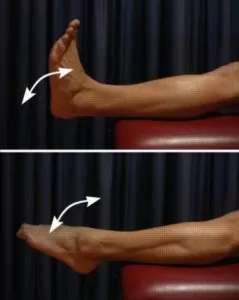
Foot & Ankle In & Out
Move your foot and ankle in and out as far as you can go without pain and provided you feel no more than a mild to moderate stretch (figure 3). Repeat 10 – 20 times provided there is no increase in symptoms.
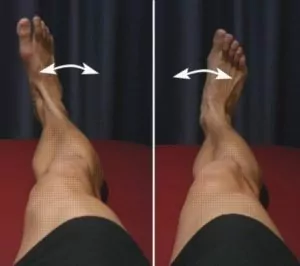
Foot and Ankle Circles
Move your foot and ankle in a circle as large as you can go without pain and provided you feel no more than a mild to moderate stretch (figure 4). Repeat 10 – 20 times in both clockwise and anticlockwise directions provided there is no increase in symptoms.
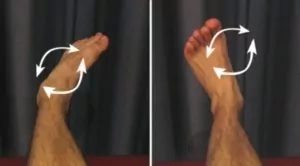
More Initial Exercises

Members Only ContentBecome a PhysioAdvisor Member to gain full access to this exclusive content. For more details see Become a Member. Already a member? Login Now
Intermediate Exercises

Members Only ContentBecome a PhysioAdvisor Member to gain full access to this exclusive content. For more details see Become a Member. Already a member? Login Now
Advanced Exercises

Members Only ContentBecome a PhysioAdvisor Member to gain full access to this exclusive content. For more details see Become a Member. Already a member? Login Now
Other Exercises

Members Only ContentBecome a PhysioAdvisor Member to gain full access to this exclusive content. For more details see Become a Member. Already a member? Login Now
Rehabilitation Protocol for retrocalcaneal bursitis

Members Only ContentBecome a PhysioAdvisor Member to gain full access to this exclusive content. For more details see Become a Member. Already a member? Login Now
 Physiotherapy products for retrocalcaneal bursitis
Physiotherapy products for retrocalcaneal bursitis
Some of the most commonly recommended products by physiotherapist for patients with retrocalcaneal bursitis include:
-
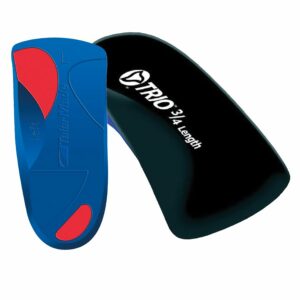 Talar Made TRIO Orthotics (3/4 length)
Talar Made TRIO Orthotics (3/4 length) -
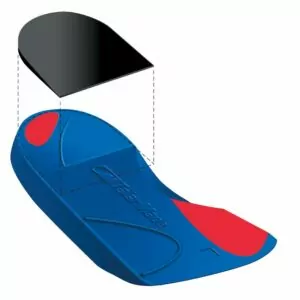 Heel Lifts (Elevators – Talar Made) (Pack of 5 Pairs)
Heel Lifts (Elevators – Talar Made) (Pack of 5 Pairs) -
 Forearm Crutches Adjustable – Standard Grip
Forearm Crutches Adjustable – Standard Grip -
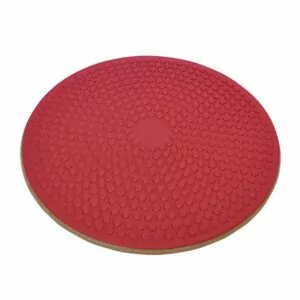 AllCare Wobble Board (Red – ACWOBRD)
AllCare Wobble Board (Red – ACWOBRD) -
 Premium Strapping Tape 38mm (Victor)
Premium Strapping Tape 38mm (Victor) -
 AllCare Tubing
AllCare Tubing -
 AllCare Spikey Massage Ball
AllCare Spikey Massage Ball -
 AllCare Instant Cold Pack (15 x 25cm)
AllCare Instant Cold Pack (15 x 25cm) -
 Comffit EVA Heel Lifts (Pack of 2 Pairs)
Comffit EVA Heel Lifts (Pack of 2 Pairs) -
 AllCare Foam Roller Round
AllCare Foam Roller Round -
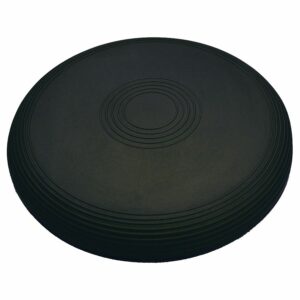 Lournet Stability Dura Disc
Lournet Stability Dura Disc -
 Tubigrip
Tubigrip
To purchase physiotherapy products for retrocalcaneal bursitis click on one of the above links or visit the PhysioAdvisor Shop.
 Relevant physiotherapy exercises
Relevant physiotherapy exercises
- Calf Stretches.
- Calf Strengthening Exercises.
- Balance Exercises.
- Leg Stretches.
- Leg Strengthening Exercises.
- Core Stability Exercises.
 Recommended Reading
Recommended Reading
- How to Use Crutches.
- Ice or Heat.
- R.I.C.E. Regime.
- Inflammatory Pain.
- Choosing a Shoe.
- Do I Need Orthotics?
- Arch Support Taping.
- Return to Running Program.
- Returning to Sport.
- Why is my Injury not Improving?
- Achilles & Heel Diagnosis Guide.
 Find a Physio for retrocalcaneal bursitis
Find a Physio for retrocalcaneal bursitis
Find a physiotherapist in your local area who can treat retrocalcaneal bursitis.
Become a PhysioAdvisor Member
-
 Individual Membership (12 Months)$59.95 for 1 year
Individual Membership (12 Months)$59.95 for 1 year -
 Individual Membership (3 Months)$39.95 for 3 months
Individual Membership (3 Months)$39.95 for 3 months -
 Individual Membership (Yearly)$49.95 / year
Individual Membership (Yearly)$49.95 / year -
 Individual Membership (Monthly)$15.95 / month
Individual Membership (Monthly)$15.95 / month

Link to this Page
If you would like to link to this article on your website, simply copy the code below and add it to your page:
<a href="https://physioadvisor.com.au/injuries/achilles-heel/retrocalcaneal-bursitis”>Retrocalcaneal Bursitis – PhysioAdvisor.com</a><br/>Detailed physiotherapy information on Retrocalcaneal Bursitis including causes, symptoms, diagnosis, treatment, exercises, rehab protocol and more...
Return to the top of Retrocalcaneal Bursitis.
